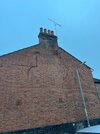I am looking at a Victorian end terrace, there is however a vertical crack down the left hand side. It does look like there has been some dodgy repointing, with cement instead of lime mortar too, not sure if this could be the cause or merely making a symptom of a problem worse. It doesn't look fresh. Does look like there was another crack between the top right hand side of the door and the window which may indicate subsidence.
All of the other terraces have no visible cracks, rooflines look fine etc.
There are no internal cracks/no dampness and the gable end of the terrace as well as the back of the house is fine.
Can anyone offer any advice?


All of the other terraces have no visible cracks, rooflines look fine etc.
There are no internal cracks/no dampness and the gable end of the terrace as well as the back of the house is fine.
Can anyone offer any advice?



